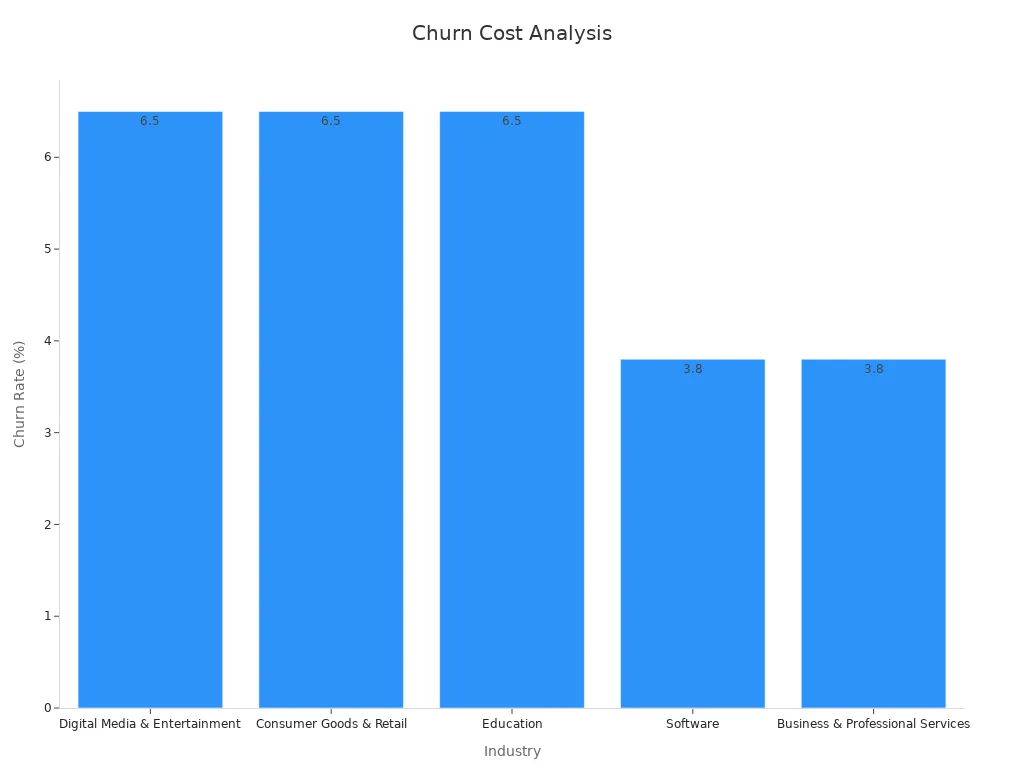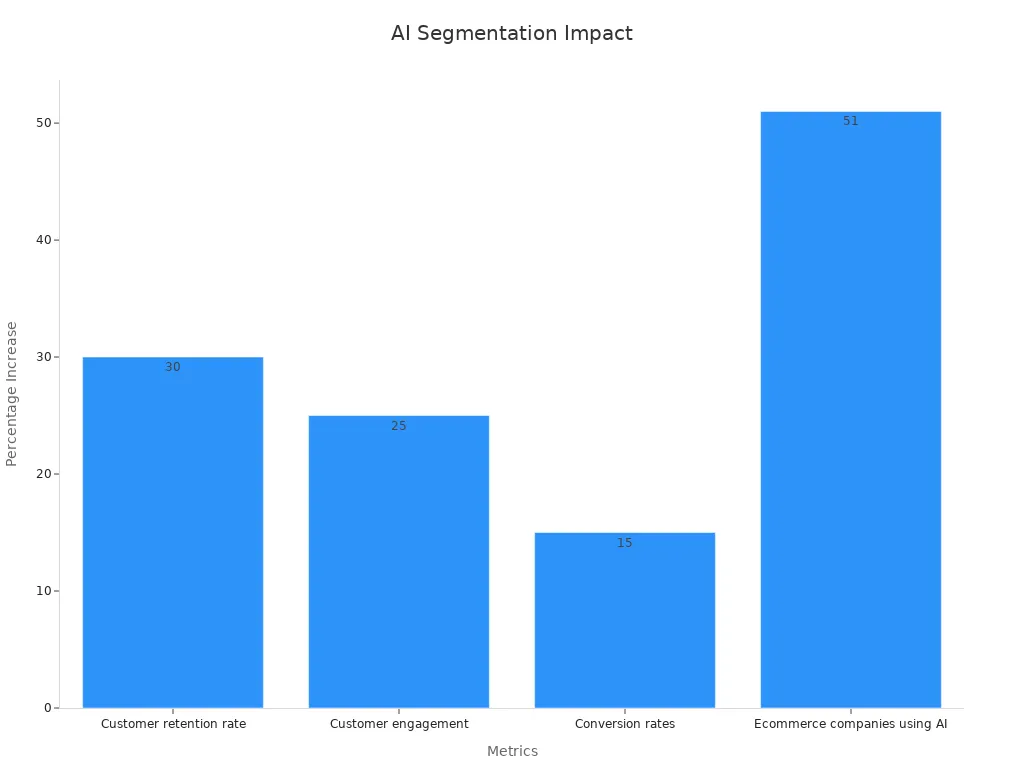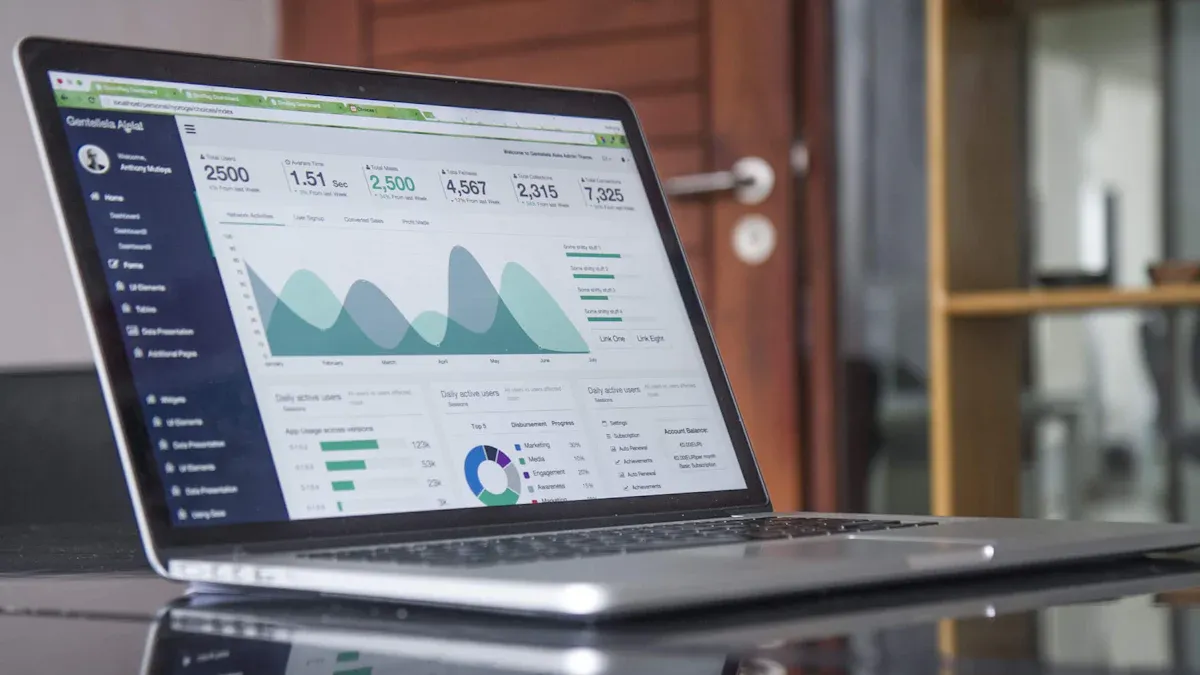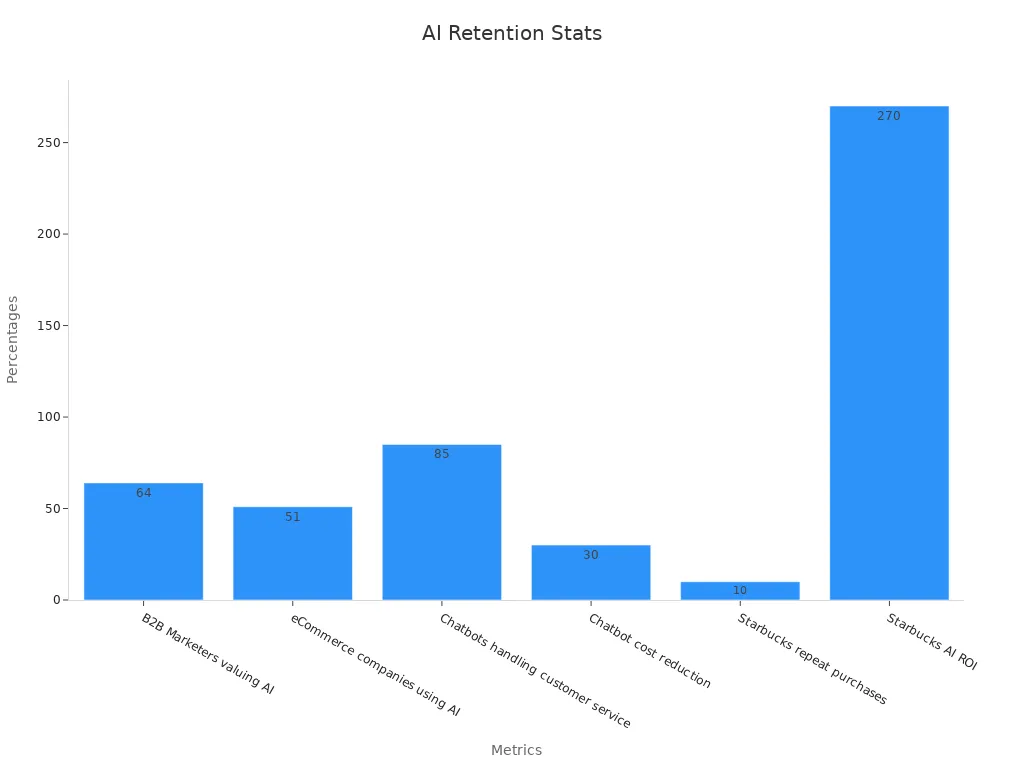AI Tools for Segment-Specific Retention Guides

You can improve how many customers stay with you by using top ai tools. These tools give plans for each group of customers and show clear results. Look at these best choices:
AI Tool | Core Value |
|---|---|
Amplitude | Strong analytics and group sorting for smart personalization. |
Hook | Predicts upsell, cross-sell, and active engagement by customer group. |
Forethought AI | NLP-powered chatbots and retention tips for quick help and custom experiences. |
Eclipse AI | Gives personal suggestions based on what customers do and like. |
Intercom | Offers live help and special messages for different customer groups. |
Recent facts show why keeping customers is important:
If you keep 5% more customers, profits can go up by at least 25%.
Current customers buy 60-70% of the time.
Returning customers spend 33% more than new ones.
Ai tools help you send the right message to the right customer. This makes things more personal and helps your business grow for a long time.
Key Takeaways
AI tools help you put customers into groups. You can send special messages to each group. This helps keep customers coming back. Keeping only 5% more customers can make profits much higher. It can go up by as much as 95%. This shows that keeping customers is very important. Customer segmentation means splitting people into groups. These groups are based on what they do, what they need, or how much they are worth. This helps make marketing and retention better. Real-time AI analytics help you watch customer groups. You can change your plans fast to keep customers happy. Many businesses get more sales and loyalty with AI-powered retention strategies. These strategies are made for each customer group.
Why Customer Retention Matters
Cost of Churn
When a customer leaves, you lose more than just money. Churn means you lose sales and waste your marketing work. You also miss chances to make customers loyal. Different industries have different churn rates. Digital media, retail, and education have higher churn. Software and business services have lower churn. The table below shows how churn is different in each industry:
Industry | Average Churn Rate | Notes on Churn Type and Impact |
|---|---|---|
Digital Media & Entertainment | ~6.5% | Higher churn, mostly voluntary; influenced by price sensitivity |
Consumer Goods & Retail | ~6.5% | Similar to Digital Media; DTC businesses have higher churn |
Education | ~6.5% | Seasonal churn patterns, linked to school year |
Software | ~3.8% | Lower churn; B2B customers with longer-term subscriptions |
Business & Professional Services | ~3.8% | Lower churn; integral to customer operations |

Churn makes your business lose real money. In 2024, companies used churn management tools to get back $1.3 billion. Some businesses kept 72% of customers who might have left. They also saw their revenue go up by 8.6% in the first year. Lowering churn helps you keep more happy customers and protects your profits.
Benefits of Improved Customer Retention
When you work on keeping customers, you get many good things. Loyal customers buy more often and spend more money. It costs five times more to get a new customer than to keep one you already have. Here are some important benefits:
61% of small and medium businesses say most of their money comes from repeat customers.
Loyal customers can be worth up to 10 times their first buy.
If you keep 5% more customers, profits can go up by 25% to 95%.
Companies with strong customer data management keep 62% more customers.
Better retention plans can lower churn by 33%.
Costs go down by 28% when customers stay happy.
Marketing works 34% better, saving a lot of money each year.
You make stronger relationships by making customers happy and giving them a good experience. This leads to more loyalty and helps your business grow for a long time. When you invest in keeping customers, you start a cycle of success and satisfaction.
Segment-Specific Retention Explained
Customer Segmentation Basics
You can keep more customers if you know about customer segmentation. Customer segmentation means you put customers into groups. You use things like age, where they live, what they like, and what they do. This helps you learn what each group wants. You can make groups like value-based segmentation, needs-based segmentation, and behavioral segmentation.
Tip: Customer segmentation lets you send the best message to each group. This makes customers happier and helps them stay loyal.
There are many ways to group your customers:
Demographic segmentation puts people in groups by age, gender, or money.
Geographic segmentation sorts people by where they live.
Needs-based segmentation finds out what each person wants.
Behavioral segmentation looks at how people use your product or service.
Value-based segmentation groups people by how much they help your business.
Behavioral segmentation can track things like buying or visiting your website. Customer journey analysis shows how each group moves through the customer journey. This helps you find problems and make things better for every group.
How Segmentation Boosts Retention
Customer segmentation helps you send the right message to each group. This makes customers feel important and want to come back. Behavioral segmentation can show which groups might leave soon. You can then do something to keep them.
Here is how segmentation helps your business:
Customer segmentation puts users in groups by age, place, interests, and actions.
Behavioral cohorts group users by what they do, like buying or using your service.
Predictive cohorts help you see which groups might leave soon.
You can make special offers for each group to keep them and earn more.
When sales and marketing match the groups, your business grows.
You can use metrics like repeat purchase rate, engagement rate by group, renewal rate, and customer revenue growth rate. These show how well your segment-specific retention works. When you check group performance, you see which groups need more help. This lets you make the experience better and keep more customers in every group.
AI Tools for Customer Segmentation

Dynamic Segmentation with AI
AI tools help you group customers faster and smarter. These tools look at things like what people buy and how they use your website. They also check how often people talk to your business. Tools like Insight7 and AWS Marketplace use AI models for this. These models make groups that change when new data comes in. Your customer groups always match what people want right now.
Generative AI can find new ways to group people by looking at what they do and how much they spend. For example, it can find people who only shop during sales. It can also spot those who like needs-based segmentation. AI feedback tools show what each group cares about most. You can use this to make special groups and send the best message to each one.
AI-powered models look at what customers did before to guess what they will do next. You can use these guesses to keep people happy and stop them from leaving. When you mix attitudinal and behavioral segmentation, you get small groups that help your marketing work better and reach your goals.
Note: Dynamic segmentation lets you change groups right away, so you always know what your customers like.
Real-Time Analytics for Retention
Real-time analytics give you quick facts about how your groups are doing. You can check things like how many customers stay, how much they join in, and how many buy. AI tools show which groups need more help and which are doing well. You can use these tools to watch how each group does and change your plans fast.

Big companies like Netflix and Salesforce Einstein use AI analytics to make things personal for each group. This makes customers happier and more loyal. Reports say AI segmentation can help you keep 30% more customers and boost engagement by 25%. You can also use analytics to see how your groups do and if your plans work.
Customer segmentation tools let you use data from places like surveys and feedback. This helps you find trends and spot problems. You can use these facts to make better offers and keep more customers coming back.
Top AI Tools for Retention
Insight7
Insight7 helps you learn about your customers with smart segmentation. You can put people in groups by what they do and like. The tool uses AI to spot patterns in how customers act. It shows you which groups need more help. You can send messages that fit each group’s needs. The platform gives you simple reports. These reports show which plans work best. You can change your plan fast when you see new trends.
Tip: With Insight7, you can notice small changes in groups and act quickly to keep more customers loyal.
CleverTap
CleverTap lets you make changing customer groups. You can watch how each person uses your app or website. The AI tools in CleverTap find groups that may leave soon. You can send special offers or messages to keep them. CleverTap gives you real-time facts. You see which campaigns work and which do not. The tool makes it easy to try new ideas and improve retention. Many businesses use CleverTap to get more customer engagement and loyalty.
80% of people like brands that give personal experiences.
42% feel upset when messages do not match their needs.
CleverTap helps you avoid this by making every message matter.
Salesforce Einstein
Salesforce Einstein uses AI for customer groups and personalization. You can use it to guess what each customer wants next. The tool looks at past actions and finds patterns. You get tips for the best way to reach each group. Salesforce Einstein also gives you strong reports. You can check how well your campaigns work. Many companies see a big rise in retention with Einstein.
Metric | Result with Salesforce Einstein |
|---|---|
ROI over 3 years | 299% |
Increase in retention | 35% |
Higher campaign performance | 24% |
You can trust Salesforce Einstein to help you keep more customers and grow your business.
Blueshift
Blueshift gives you strong AI tools for customer groups. You can make groups by real-time actions and likes. The platform uses machine learning to find the best way to talk to each group. You can send emails, push messages, or ads that match what each customer likes. Blueshift also gives you facts on how each group reacts. You can see which messages work best and change your plan if needed. This helps you keep your customers happy and loyal.
Note: 59% of marketers use AI to make messages more personal. Blueshift makes this simple for you.
Adobe Sensei
Adobe Sensei uses AI to help with customer groups and personalization. You can find out what each group wants by looking at lots of data. The tool helps you make small groups, so every message feels personal. Adobe Sensei also gives you strong reports. You can see which campaigns bring the best results. Many marketers think AI like Sensei will change marketing by 2025.
Metric with Adobe Analytics | Result |
|---|---|
Conversion rate increase | 23% |
Less marketing waste | 19% |
More revenue opportunities | 20% |
You can use Adobe Sensei to make sure your messages always fit your customer groups.
AWS Marketplace Solutions
AWS Marketplace has many AI tools for customer groups and retention. You can pick tools that use machine learning to group customers. These tools help you spot trends and guess who might leave. You can also automate your messages and offers. AWS Marketplace tools give you easy dashboards for insights. You can track how each group reacts and change your plan fast. Companies like Netflix use AI to make thousands of customer groups for better recommendations.
AI tools from AWS help you save time by automating reports and cleaning data.
You can use these tools to watch brand feeling and change ad bids in real time.
Many businesses see higher retention and better customer experiences with AWS solutions.
Implementing AI Tools for Improved Customer Retention
Data Collection and Preparation
You begin by gathering the right data. Good data helps you know your customers better. First, set clear goals for your AI tools. Pick areas that will help most, like onboarding or support. Collect customer data from many places, such as CRM systems, surveys, and social media. Use both structured and unstructured data.
Next, clean your data. Take out duplicates and fix mistakes. Make sure all formats match. This step helps your analytics give good results. Change your data by making new features and splitting it for AI modeling. Write down your steps and keep your data neat. Use automation to save time and avoid errors. When your data is ready, you can make strong groups and keep more customers.
Tip: Use automation to collect and combine data. This keeps your information current and correct.
Mapping Personas to Lifecycle Stages
After your data is ready, match customer personas to their lifecycle stages. Personas are groups of customers with similar traits or actions. Use segmentation to sort customers into these groups. Look at what they do, what they like, and who they are. This shows where each persona is in the customer journey.
Find important moments that affect retention. For example, the first claim can matter to 89% of customers. Renewal times affect 67%, and fixing problems matters to 78%. Talking early and using many channels also helps. Map out when customers feel good or bad during their journey. This helps you know how they feel at each stage.
Use customer journey analysis to find ways to improve. AI tools help you track these stages and change your plan for each group. When you match personas to lifecycle stages, you can send the right message at the right time.
Setting Up AI-Powered Retention Campaigns
Now use your groups and analytics to make AI-powered retention campaigns. Start by making content that fits each group’s needs. AI tools like Robotic Marketer help you make messages and offers personal. Automate your email marketing and CRM tasks to reach customers at the best times.
Use AI marketing platforms to study customer data and guess who might leave. Use this to make special campaigns for each group. Set up loyalty programs with AI to reward repeat customers. Use AI tools on social media to plan posts, watch feedback, and check how people feel.
AI chatbots can give support all day and night. This makes customers feel important. Real-time analytics let you watch how your campaigns do and change your plan fast. This helps you keep each group interested and loyal.
Note: Watching campaigns in real time lets you change targeting, ad spend, and content for each group quickly.
Measuring and Refining Retention Strategies
After you start your campaigns, you need to see how well they work. Use dashboards to track key numbers like retention rate, customer lifetime value, and churn rate. Predictive analytics help you guess what customers will do and spot trends early. Watch reviews and social comments to find new needs or problems.
Check how each group reacts to your campaigns. AI analytics show which messages work best and which need fixing. Make self-service easy to lower support calls. Over a year, you can see big changes: customer satisfaction can go from 6.8 to 8.4, claims satisfaction can reach 89%, and retention can go up by 34%. Net Promoter Scores can rise from 23 to 67, and customer lifetime value can grow by 41%.
Keep making your strategies better with real-time insights. Always watching and changing your plan helps you meet customer needs and keep your groups loyal.
Remember: Always improving with AI analytics helps you keep customers for a long time.
Customer Retention Success Stories

E-commerce Example
AI tools help e-commerce companies keep more customers. Super.com used AI to test and change their website features. This made more customers stay in just one month. When you use AI, each customer gets a better experience. Studies say 90% of people spend more with companies that give personal service. AI looks at customer data and helps you show the right content to each person. This makes customers happier and more loyal.
Company | Sector | AI Tool/Strategy | Quantitative Result/Impact |
|---|---|---|---|
Super.com | E-commerce | AI-driven experimentation to refine features |
SaaS Example
SaaS companies use AI to help keep their customers. SafetyCulture used an AI tool to change documents. This made it easier for users to publish, so publishing went up by 20%. Paired, another SaaS company, made onboarding simple with AI. When you use AI to help new customers, fewer people cancel trials and more people use your product. AI checks how customers use your product and finds those who might leave. You can send special messages to keep them interested and happy.
Company | Sector | AI Tool/Strategy | Quantitative Result/Impact |
|---|---|---|---|
SafetyCulture | SaaS | AI-powered document conversion | 20% increase in publishing rates |
Paired | SaaS | Data-driven onboarding simplification | Decrease in trial cancellations and improved engagement |
Nonprofit Donor Retention
Nonprofits also use AI tools to keep donors. AI can track what donors do and send messages that fit their interests. This gives supporters a better experience. Many nonprofits keep more donors and make them happier with AI. Studies show 70% of people choose based on good service. When you use AI to make service better, donors are happier and come back every year.
Tip: AI tools help you learn what matters most to your donors. This helps you build trust and strong relationships.
AI tools help you make each customer group happy and loyal. You can see real changes, like more people buying again and spending less money. Many businesses now use AI to keep more customers. The table below shows how AI helps:
Metric / Insight | Statistic / Result | Impact on Customer Retention and AI Adoption |
|---|---|---|
B2B Marketers valuing AI in marketing | Strong industry recognition of AI's value | |
eCommerce companies using AI | 51% | Better customer experience and retention |
Chatbots handling service | 85% | More customer engagement, lower costs |
Starbucks Deep Brew AI repeat purchases | 10% | Higher customer retention |
Starbucks Deep Brew AI ROI | 270% in 18 months | Big financial return from AI |

You can try a demo, start a free trial, or talk to a retention expert. Keep using data to make your customer plans even better.
FAQ
What is segment-specific retention?
Segment-specific retention means you keep different groups of customers happy in different ways. You use data to find out what each group likes. Then you send messages or offers that fit each group best.
How do AI tools help with customer retention?
AI tools help you find patterns in customer data. You can use these patterns to predict who might leave. The tools suggest actions to keep each group interested and loyal.
Can small businesses use AI retention tools?
Yes, you can use AI retention tools even if you run a small business. Many tools offer easy setups and simple dashboards. You do not need a big team or special skills to get started.
How do I measure if my retention strategy works?
You track numbers like repeat purchases, customer lifetime value, and churn rate. AI tools show these numbers in real time. You can see what works and change your plan quickly.
See Also
A Complete Guide To Analyzing Your Competitors Effectively
Top Ten Free Tools To Generate Winning SEO Keywords
Strategies For Analyzing Content To Beat Your Competitors

